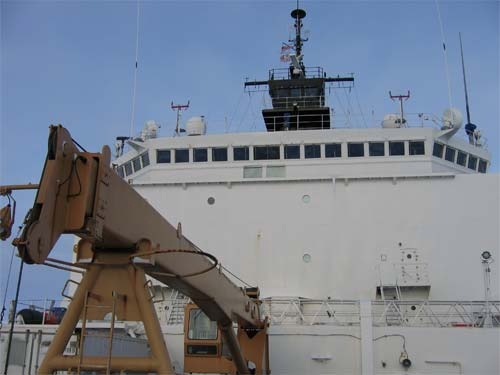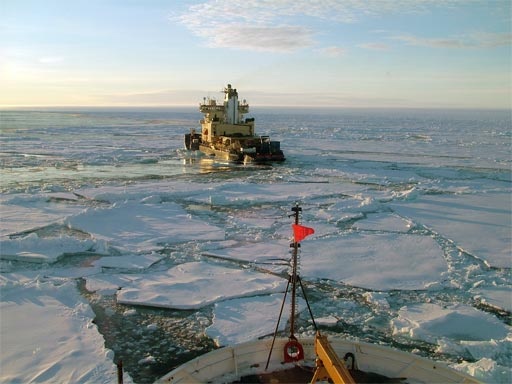( Log In ) Log In is for TREC Teachers & Researchers only
  |
| Ute_Kaden |
 Sep 16 2005, 06:06 PM Sep 16 2005, 06:06 PM
Post
#1
|
 TREC Teacher    Group: TREC Team Posts: 203 Joined: 27-April 05 Member No.: 10 |
Loft Conn
TREC 9-15-05 Ship Position at 2005/09/15 19:48:01 UTC Longitude: 58 41.744 E Latitude: 88 3.357 N "IBCAO" depth: 4251 m Air Temperature: dropped to -15 C—very cold! Water: - 1.77C After leaving the North Pole heading South was difficult. Heavy multi year ice under high compression due to the persistent winds made it difficult for both ships to cut through.  Sea ice with pressure ridges up to 18m thick. The Captain got called to the Bridge in the middle of the night and drove the ship from the loft conn out of the danger zone.  Loft conn is the highest point of the ship for navigation. It is easy to get stuck under conditions like this. The loft conn is located on top of the bridge and gives the navigator and the ship driver an excellent overview of the surroundings. It takes lots of experience to find a possible way out of the heavy packed ice floes. Captain Dan Oliver has the knowledge and the skills and once more saved the day. Later, the ice group around Don Perovich went on the ice to collect data and Dennis Darby and Martin Jacobsson collected the 11th dirty ice sample. The samples will provide a good cross-section of the sediment sources of the pack ice across the Arctic. The Fe (iron) grains contained in the sediment from the ice will provide a fingerprint that can be matched to specific source areas around the Arctic. This sediment gets into sea ice when the ice forms in water shallower than 30 meters along the continental shelf area. Wednesday Night, Dr. Leonid Polyak gave a science talk about sediment cores and what they tell us about recent climate changes.  Dr. Leonid Polyak during his science talk. Data suggests that colder periods and warmer periods occur in cycles. The processes leading to those cycles are not well understood yet. Scientists hope that the data collected on this cruise will help to solve some of the mysteries of the Arctic Ocean. The next coring site will be on the Gakkel Ridge, the very slow seafloor spreading center in the Arctic Ocean. Oden is due into Longyearben, Svalbard on the 25th, we decided to separate on the 20th. Hopefully, ice condition will allow the ships to go their separate ways. It was good international teamwork to go over the Pole supporting each other.  Oden in front of Healy breaking ice. We have changed our time to Norwegian time, this is + 2h to UTC time or +10 hours to Alaska Time. We are confused, tired and hungry at odd times. We are having jet lag without flying. I used the day to interview the Captain and I got a physics engineering tour to learn about the auxiliary systems of the ship. More about this tomorrow. It is 2:20 am and I am somewhat tired. Cheers, Ute Kaden |
  |
2 User(s) are reading this topic (2 Guests and 0 Anonymous Users)
0 Members:

|
NSF Acknowledgment & Disclaimer | Time is now: 30th October 2024 - 11:36 AM |
Invision Power Board
v2.1.7 © 2024 IPS, Inc.








